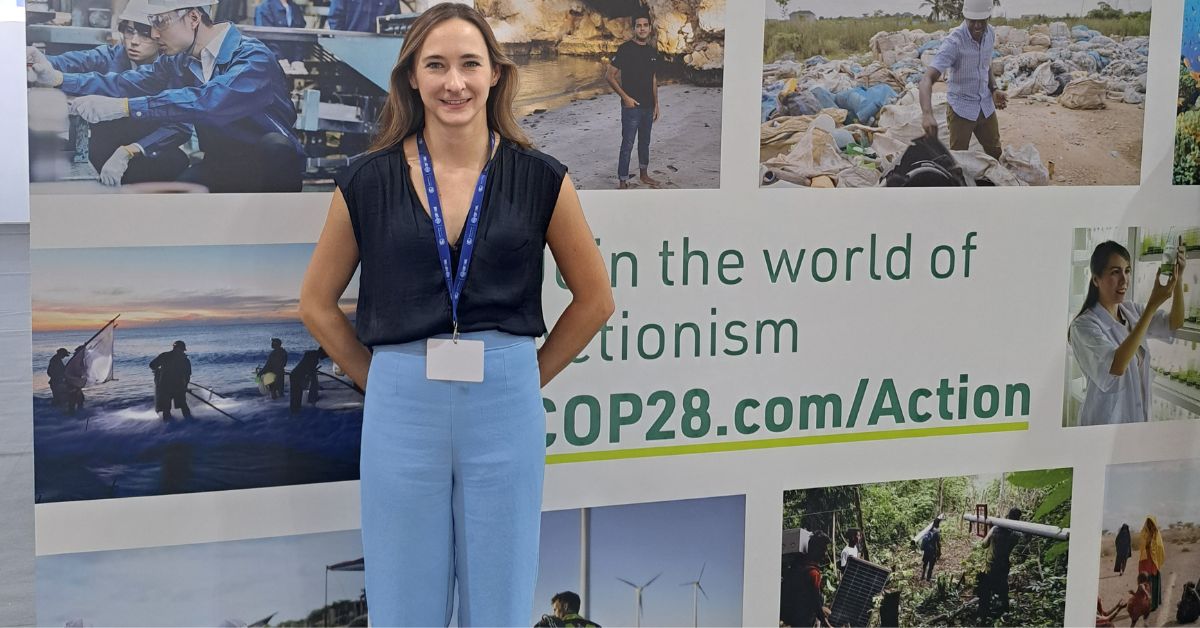DUBAI — Companies and countries are contemplating foreign investment policies that need to be aligned with the net-zero transition, says Kimberley Botwright, Head of Sustainable Trade at the World Economic Forum.
This global forum connects game-changers and leaders from governments, business, philanthropy, and civil society to collectively debate issues of global concern.
Elaborating on this point, Botwright refers to the latest WTO report, “Trade Policy Tools for Climate Action,” which examines trade policy options for climate action. The report highlights that tariffs on fossil fuel products are often much lower than those on renewable energy and clean technology.
“We need to realign our economic incentives to be able to support and send the right signals to the market,” she says.
Botwright spoke to TRENDS during the first-ever Trade Day, part of The United Nations Climate Change Conference COP28. This annual forum gathers governments to discuss and plan the roadmap for global climate action and is being held in Dubai from November 30 to December 12.
Botwright appraises the partnership talks held in the initial days of COP28 as “very good,” underscoring the unprecedented inclusivity of trade on the agenda in the forum’s three-decade history, which she views as conveying “a huge signal.”
When asked to assess the first four days of COP28, particularly regarding the shift from pledges to action, Botwright expresses satisfaction with the potent level of engagement and the diverse range of participants at the convention.
“This is exactly what we need,” she says, highlighting the presence and participation of stakeholders from commercial and development banks, development finance, project developers, and governments, all contributing to environment projects.
A key takeaway from COP28 within the trade debate is the importance of uniting the public and private sectors to jointly drive the green agenda. In the same vein, the supply chain needs to operate in public-private partnerships, says Botwright, emphasizing that we are currently witnessing an increase in regulations related to supply chain emissions, classified as Scope 3.
Companies have already started to report and act on their Scope 3 emissions through private initiatives and when establishing targets through entities such as the Science Based Targets initiative (SBTi).
“There is a surge in regulations emerging from the EU, with the expectation for other markets to follow suit,” she said. She stressed that companies will increasingly need to report on and work to reduce their supply chain emissions. “We can do a lot in that space.”
Trade and climate change go hand in hand – a notion that is evident in the succinct definition of sustainable trade. Botwright defines sustainable trade as a combination of trade and investment policies that support green activities.
She sets out critical points: “How do you move goods across borders and how are we doing this in an efficient way that reduces emissions? How are we applying the right technologies for lower emissions ability? How do we have trade spread the use of technologies worldwide?”
In illustrating this viewpoint, Botwright highlights the nexus where trade and sustainability intersect: “Trade has contributed up to 40 percent of the falling costs of solar power, for example. That means that if we did not have trade today, first, there would be a lot of countries without solar power, but the countries that did have it, the solar power would be a lot more expensive.”
In providing her perspective on potential trade solutions for the climate action roadmap, Botwright outlines several key measures. These include reducing tariffs on clean technologies, driving green Foreign Direct Investments, and aligning all with international standards for emissions measurement and calculations.
Additionally, she underscores the importance of opening up government procurement and increasing cross-border government procurement activities, spotlighting these actions as powerful market signals.
She stressed the need to consider the supply chain and how the adoption of technologies is incentivized in countries that produce the goods we consume. “That will be really important going forward,” she says.
Botwright also emphasized the role of development cooperation in complementing efforts to reduce emissions. “It shouldn’t be on companies alone to reduce their emissions. We need a lot of support to get technologies, especially into emerging markets where many of these emissions are generated,” she explains.
Technological advancement and innovation are pivotal for the greener planet blueprint. When asked if technology, such as Artificial Intelligence (AI), is seen as an accelerator for the global sustainability agenda, Botwright advocates that technology can contribute to more efficient trade.
Elaborating further, she introduces a technological trade initiative held in partnership with the UAE, addressing the application of new technologies to expedite the movement of goods across borders.
Financial capital is vital to accelerating the climate commitments set for 2030 and 2050. Citing the latest UN estimates, Botwright explains that the amount of investment needed is immense. “We need $125 trillion to get to net-zero. By 2030, we need between US$4 trillion and US$5 trillion a year.”

